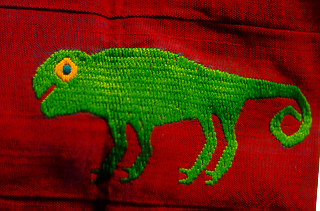Jan 25, 2016
Ewe Kente Weaving
Traditionally, kente is woven in Ghana by the Asante and the Ewe. The Asante kente is woven in villages just outside Kumasi in the area around Bonwire, Woonoo, Maape, Adawomase and Ntonso. Kente is also woven by the Ewe in the Volta Region. Even though Asante and Ewe kente may look very similar, there are significant differences, especially in the weft designs and in some technical areas with respect to the weaving process. Ewe kente is often identified by its figurative motifs.
Cloth weaving in the Volta Region of Ghana is centered around Kpetoe (Agotime Kpetoe, Agotime Agbenyinanse), Anlo and Somme areas (Denu, Agbozumey, Klikor, Wheta, Keta), and Mafi-Kumase area in the Tongu district as well as the Kpandu area of the northern Volta Region. Ewe weavers utilize an almost identical form of the narrow-strip loom to that of the Asante, and there is considerable evidence to suggest mutual influence between the weavers of the two traditions, as might be expected from the long history of contacts, both through trade and conquest between their peoples.
The Akan and the Ewe have used cloth not only for personal adornment but also as a powerful expressive medium of communication. Among the Ewe as well as the Akan kente cloth is a store of knowledge: skills and knowledge inherent in the weaving process; mathematical ideas (geometric shapes, number counting and number series, and tessellation); and the belief systems and history of the people.
The first step in preparing cotton bolls ready for weaving is ginning, the removal of cotton seeds. This is done by bowing and fluffing. The fluffed cotton is then spurn using a distaff and a spindle. The fluffed cotton is drawn out and twisted to produce a continuous strand - a yarn. The yarn is then washed and dyed.
The process of weaving a cloth involves the successive passing of the weft thread through an alternating space, or shed, between the warp threads. The up and down movement of the heddles produced by operating the foot pedals, separates the warp threads so that the shuttle carrying the weft can be passed through. The heddles are then moved to reverse the position of the warp threads and the shuttle is again passed through the shed. The work continues in this way until the required length of cloth has been woven. The materials to be woven must be prepared in advance. In the past locally grown cotton spun by hand was the most widely used material but to a large extent this has been replaced by machine-spun cotton, silk, rayon, and lurex. Other local material used in weaving included a thread from the raffia palm. The product of this was called doso in Akan. The vegetable dyes traditionally used for coloring yarns have also been widely replaced by commercial products.
Kente weaving areas in the Vo;ta Region are centered around
Abgozumey
Klikor
Wheta
Denu
Kpetoe
and Mafi Kumasi
Other crafts in the Volta Region include wood carving (drums), mat weaving and pottery.
Click here to visit gallery

